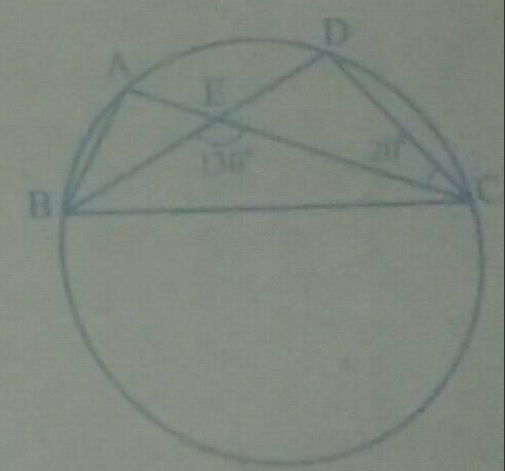In Fig. 10.39, A, B, C and D are four points on a circle. AC and BD intersect at a point E such that ∠BEC\ =\ 130o and ∠ECD\ =\ 20⊙ Find ∠BAC.
To solve the problem, we need to find the angle ∠BAC given the angles ∠BEC=130∘ and ∠ECD=20∘.
1. Identify the Angles:
We have ∠BEC=130∘ and ∠ECD=20∘.
2. Use the Exterior Angle Theorem:
In triangle EDC, the exterior angle ∠BEC is equal to the sum of the two opposite interior angles ∠ECD and ∠CDE:
∠BEC=∠ECD+∠CDE
Substituting the known values:
130∘=20∘+∠CDE
3. Solve for ∠CDE:
Rearranging the equation gives:
∠CDE=130∘−20∘=110∘
4. Relate ∠CDE to ∠BDC:
Since ∠CDE is the same as ∠BDC (they are vertically opposite angles), we have:
∠BDC=110∘
5. Use the Inscribed Angle Theorem:
The angle ∠BAC is equal to ∠BDC because they subtend the same arc BC in the circle. Therefore:
∠BAC=∠BDC=110∘
Conclusion:
Thus, the measure of ∠BAC is 110∘.
We have ∠BEC=130∘ and ∠ECD=20∘.
In triangle EDC, the exterior angle ∠BEC is equal to the sum of the two opposite interior angles ∠ECD and ∠CDE:
∠BEC=∠ECD+∠CDE
Substituting the known values:
130∘=20∘+∠CDE
Rearranging the equation gives:
∠CDE=130∘−20∘=110∘
Since ∠CDE is the same as ∠BDC (they are vertically opposite angles), we have:
∠BDC=110∘
The angle ∠BAC is equal to ∠BDC because they subtend the same arc BC in the circle. Therefore:
∠BAC=∠BDC=110∘
Thus, the measure of ∠BAC is 110∘.
Topper's Solved these Questions
Similar Questions
A, B, C and D are four points on a circle. AC and BD intersect at a point E such that ∠BEC =130∘ and ∠ECD=20∘ Find ∠BAC∘

View SolutionIn Fig. 10.36, A,B and C are three points on a circle with centre O such that ∠BOC= 30o and ∠AOB= 60o. If D is a point on the circle other than the arc ABC, find ∠ADC.
View SolutionIn fig. 10, A,B,C and D are four points, and no three points are collinear. AC and BD intersect at O. there are eight triangle that you can observe. Name all the triangles.
View SolutionIn fig. 10, A,B,C and D are four points, and no three points are collinear. AC and BD intersect at O. there are eight triangle that you can observe. Name all the triangles.
View SolutionIn a ABC,D and E are points on sides ABandAC respectively such that BD=CE. If ∠B=∠C, show that DE∣∣BC.
View SolutionIn ABC, D and E are points on sides AB and AC respectively such that AD×EC=AE×DB . Prove that DEBC .
View SolutionD and E are points on sides AB and AC respectively of ΔABCsuch thatar (DBC) = ar (EBC). Prove that DE ∣∣ BC.
View SolutionD and E are points on sides AB and AC respectively of ΔABC such that ar (DBC) = ar (EBC). Prove that DE∣∣BC.
View SolutionIn a ABC , D and E are points on the sides AB and AC respectively such that DE∣∣BC If AD=6 cm , DB=9 cm and AE=8 cm , find AC .
View SolutionIn a ABC , D and E are points on the sides AB and AC respectively such that DE/BC If AD=4 , AE=8 , DB=x−4 , and EC=3x−19 , find x .
View Solution
